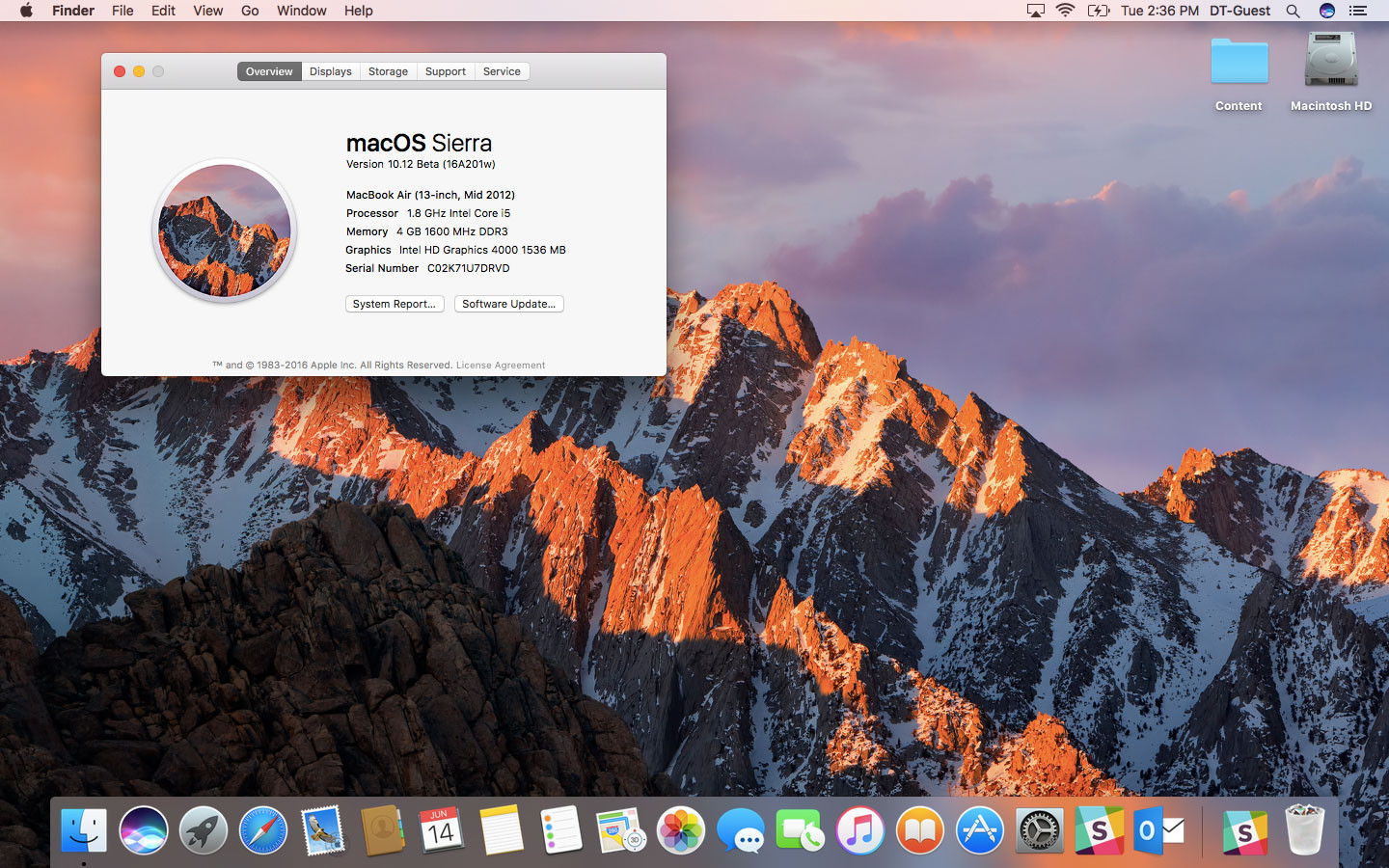ICloud authentication errors occur after download; Before starting this process make sure your computer is in good working order with plenty of space for a new download. What should I do to prepare for upgrading to macOS Sierra? Before you leap into an OSX upgrade, you should get your current Mac in good shape. I recommend the following actions.
- Install Sierra On Mac
- Should I Install Macos High Sierra On My Mac
- Can I Install Sierra On My Macbook Pro
- Mac Os Sierra Download Pc
Check compatibility
You can upgrade to macOS High Sierra from OS X Mountain Lion or later on any of the following Mac models. Your Mac also needs at least 2GB of memory and 14.3GB of available storage space.
MacBook introduced in late 2009 or later
MacBook Air introduced in late 2010 or later
MacBook Pro introduced in mid 2010 or later
Mac mini introduced in mid 2010 or later
iMac introduced in late 2009 or later
Mac Pro introduced in mid 2010 or later
To find your Mac model, memory, storage space, and macOS version, choose About This Mac from the Apple menu . If your Mac isn't compatible with macOS High Sierra, the installer will let you know.
Make a backup
Before installing any upgrade, it’s a good idea to back up your Mac. Time Machine makes it simple, and other backup methods are also available. Learn how to back up your Mac.
Get connected
It takes time to download and install macOS, so make sure that you have a reliable Internet connection. If you're using a Mac notebook computer, plug it into AC power.
Download macOS High Sierra

For the strongest security and latest features, find out whether you can upgrade to macOS Catalina, the latest version of the Mac operating system.
If you still need macOS High Sierra, use this App Store link: Get macOS High Sierra.

Begin installation
After downloading, the installer opens automatically.
Click Continue and follow the onscreen instructions. You might find it easiest to begin installation in the evening so that it can complete overnight, if needed.
If the installer asks for permission to install a helper tool, enter the administrator name and password that you use to log in to your Mac, then click Add Helper.
Allow installation to complete
Please allow installation to complete without putting your Mac to sleep or closing its lid. Your Mac might restart, show a progress bar, or show a blank screen several times as it installs both macOS and related updates to your Mac firmware.
Learn more
- If you have hardware or software that isn't compatible with High Sierra, you might be able to install an earlier macOS, such as Sierra or El Capitan.
- macOS High Sierra won't install on top of a later version of macOS, but you can erase your disk first or install on another disk.
- You can use macOS Recovery to reinstall macOS.
Performing an El Capitan-to-Sierra upgrade is easy. Although it does not come like a push-one-button-and-proceed method, the truth is it’s quite close.
Requirements for Upgrading from El Capitan to Sierra
Before we proceed with our step-by-step guide, allow us to answer an important question that some Mac users have in mind: “Can an old Mac still upgrade to Sierra?”
The answer is, of course, a YES. However, there are a few minimum requirements that need to be met, such as the following:
- 2 GB RAM
- 8 GB Storage Space
- Mac Models: Late 2009 iMac, 2009 MacBook, 2010 MacBook Pro, 2010 MacBook Air, 2010 Mac Mini, 2010 Mac Pro
Install Sierra On Mac
Once you are certain that your Mac has met the requirements above, make sure you have backed up your Mac. This backup will come in handy in case something comes up in the process of upgrading to High Sierra.
Upgrading from El Capitan to Sierra
After backing up your Mac’s important files and folders, it’s time to get started. Here’s how to upgrade from El Capitan to Sierra.
1. Download High Sierra from the App Store.
High Sierra is available for download from the App Store. To get it, follow these steps:
- Open the Mac App Store by simply clicking on the App Store icon in the dock.
- Navigate to the Featured tab.
- Find macOS Sierra in the rightmost column and click on it.
- Click Download.
- At this point, the download will start. It may take long, especially if it’s your first time accessing the App Store. Just be patient.
- Once the download is completed, the installer should launch automatically.
2. Start the Upgrade.
With the High Sierra installer ready, it’s time to actually install it. Here’s how:
Should I Install Macos High Sierra On My Mac
- The High Sierra installer should now be open on your Mac. If you have accidentally quit it, you can restart it by going to the Applications folder and double-clicking on the installer.
- Click Continue to proceed.
- Press on the Agree button to agree with the software licensing terms and agreements flashed on your screen.
- Click on the Agree button again to verify your action.
- Hit Install.
- A new dialog box will pop up, requiring you to input your administrator password. Provide that information and click Add Helper.
- The High Sierra installer will begin copying the system files to the new target drive. The progress will show in a new window.
- As soon as all the system files are copied, your Mac will automatically reboot. Don’t panic if the restart process takes a while. It only means your Mac is coping with the installation process.
3. Utilize the Setup Assistant to Complete the Installation.
Your Mac should already be finished with the basic installation process. The next thing you should do is run the Setup Assistant to configure some important macOS High Sierra options and settings.
Take note, though, that if your Mac is configured to ask for your login details, a normal login window will show. Provide your login credentials so you can proceed with the following steps:
- The Setup Assistant starts off by asking you for your Apple ID details. If you wish to leave everything as it is, click the Set Up Later option.
- Let the Setup Assistant configure all vital services that need your Apple ID credentials. Simply provide your Apple ID password and hit Continue.
- Click Agree if you agree with the Terms and Conditions flashed on your screen.
- You will be asked to verify your action again. To continue, click Agree again.
- The Setup Assistant should then continue with configuring your iCloud account information. It will also ask you whether you want to set up iCloud Keychain. You can just skip it to avoid confusing yourself.
- Next, there will be options displayed on your screen regarding how you wish to use iCloud for storing images and documents. Choose which of them apply to you by clicking on the boxes next to each one of them:
- Store Files from Documents and Desktop in iCloud Drive – This option will allow you to automatically upload files from your Desktop and Documents folder to your iCloud Drive. Be mindful, though, that Apple only offers a limited amount of storage space for free users. If all this free space is exhausted, you will be asked to purchase additional storage.
- Store Photos and Videos in iCloud Photo Library – This will let you upload videos and images from your Photo Library to iCloud. As with the first option, you have to remember that you only have limited free storage space.
- Hit Continue.
- Wait for the Setup Assistant to finish the setup process.
- You will know when it’s done because you will be taken to your desktop.
Summary
We hope you found this guide useful. But before you download macOS Sierra and perform an upgrade, do not forget to clean up your Mac with a reliable Mac repair tool first. This way, you can ensure that nothing comes your way and keeps you from making the most of High Sierra.
Can I Install Sierra On My Macbook Pro
Did we miss some important steps above? Do you know other, easier methods to upgrade from El Capitan from Sierra? We’d love to know. Comment on them below!
Mac Os Sierra Download Pc
See more information about Outbyte and uninstall instructions. Please review EULA and Privacy Policy.